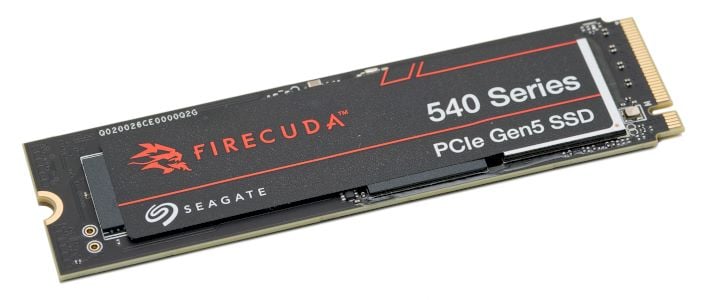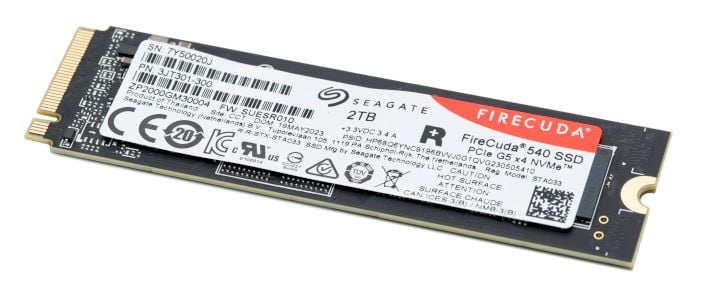Seagate FireCuda 540 SSD Review: Blazing Fast Storage For Gamers
Seagate FireCuda 540: High Performance PCIe 5 SSD For Gamers And Creators
| Seagate FireCuda 540: 2TB for $269 The speedy Seagate FireCuda 540 is a PCIe Gen 5 SSD with fast sequential transfers, which targets discerning gamers and content creators.
|
|||

|

|
||
Seagate FireCuda 540 SSD Specifications And Features

Find The Seagate FireCuda 540 PCIe 5 SSD @ Amazon
The drive itself is a fairly unremarkable-looking gumstick SSD. However, you'll note that there's no heatsink on this drive. That's not because it doesn't need one—this is a Phison E26-based platform, after all—but rather, because Seagate doesn't want to waste money on something you're probably not going to use anyway. The company figures that most users are going to stick the drive under a motherboard's cooling plate or even an active cooler, so the drive comes bare aside from stickers on both sides.
The packaging for the box is pretty cool, with a stylish red-and-black color scheme and a sticker indicating the salient points of the SSD: its capacity, its sequential speed, and the fact that it comes with a data recovery warranty. We're not sure if the dragon creature on the box is the fabled FireCuda, but the "Cuda" part comes from "Barracuda," which is a fish, so maybe we should just stop thinking about it.

Like many other SSDs in its class, the FireCuda 540 implements an SLC-like cache to enhance write performance. As you can see above, with the 2TB drive, that cache will operate at full speed until 500GB of data is sequentially written to the drive, at which point write performance dips considerably, but still remains over 3GB/s across the entire capacity of the drive.
Seagate FireCuda 540 SSD Benchmarks
Under each test condition, the SSDs showcased here were installed as secondary volumes in our testbed, with a separate drive used for the OS and benchmark installations. Our testbed's motherboard was updated with the latest BIOS available at the time of publication and Windows 11 was fully updated. Windows Firewall, automatic updates, and screen savers were all disabled before testing, and Focus Assist was enabled to prevent any interruptions.
In all test runs, we rebooted the system, ensured all temp and prefetch data was purged, and waited several minutes for drive activity to settle and for the system to reach an idle state before invoking a test. All of the drives here have also been updated to their latest firmware as of press time. Where applicable, we would also typically use any proprietary NVMe drivers available from a given manufacturer. When not available, the drives used the Microsoft driver included with Windows 11.HotHardware's Test System:
| Processor: Intel Core i9-13900K Motherboard: MSI Z790 Godlike Video Card: GeForce RTX 3080 Memory: 32GB Micron DDR5-6000 Storage: ADATA XPG GAMMIX S70 Blade (OS Drive) ADATA XPG GAMMIX S70 (2TB) Seagate FireCuda 540 (2TB) ADATA Legend 970 (1TB) Samsung SSD 990 Pro (2TB) Corsair MP700 (2TB) Crucial T700 (2TB) |
OS: Windows 11 Pro x64 Chipset Drivers: Intel v10.1.19284 Benchmarks: IOMeter 1.1 HD Tune v5.75 ATTO v4.01.01f AS SSD SiSoftware SANDRA CrystalDiskMark v8.0.4c x64 Final Fantasy XIV: Endwalker PCMark 10 Storage Bench 3DMark Storage Tests |
IOMeter Benchmarks
IOMeter is a well-respected industry standard benchmark. However, despite our results with IOMeter scaling as expected, it is debatable as to whether or not certain access patterns actually provide a valid example of real-world performance. The access patterns we tested may not reflect your particular workloads, for example. That said, we do think IOMeter is a reliable gauge for relative throughput, latency, and bandwidth with a given storage solution. In addition, there are certain highly-strenuous workloads you can place on a drive with IOMeter that you can't with most other storage benchmark tools. In the following tables, we're showing two sets of access patterns; a custom Workstation pattern, with an 8K transfer size, consisting of 80% reads (20% writes) and 80% random (20% sequential) access and a 4K access pattern with a 4K transfer size, comprised of 67% reads (33% writes) and 100% random access. Queue depths from 1 to 16 were tested...


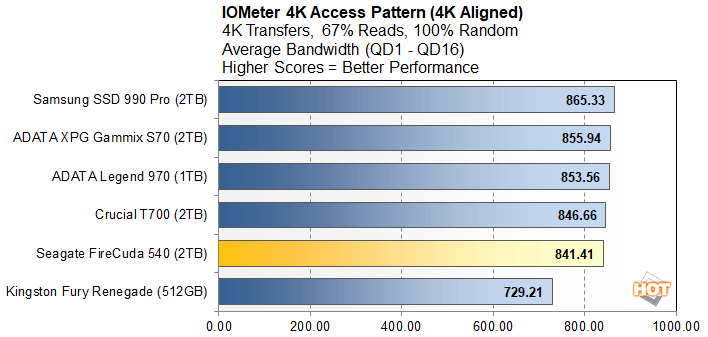
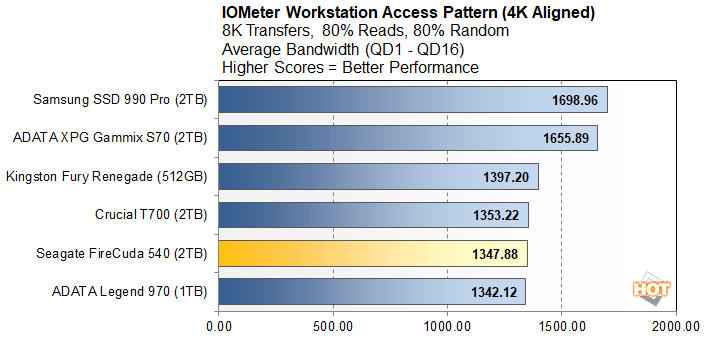


Assuming nothing has gone grievously wrong, the latency tests should look like a mirror of the bandwidth tests, which is to say that they should be reversed. That's the case here, which means that there are no real surprises—the drives that offer the best random performance also offer the lowest response time and access latency, which means everything is working as expected.
SiSoft SANDRA 2022
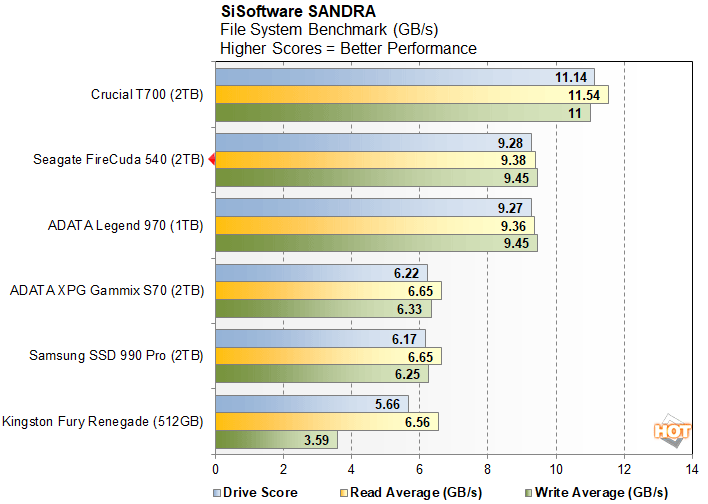
ATTO Disk Benchmark
ATTO is another "quick and dirty" type of disk benchmark that measures transfer speeds across a specific volume length. It measures raw transfer rates for both reads and writes and graphs them out in an easily interpreted chart. We chose .5KB through 64MB transfer sizes and a queue depth of 6 over a total max volume length of 256MB. ATTO's workloads are sequential in nature and measure raw bandwidth, rather than I/O response time, access latency, etc.


The write result is very impressive here, outpacing everything except the top-class Crucial T700. On the read test, the FireCuda 540 is once again neck and neck with the Crucial T700 until the critical 256KB test, although ADATA's Legend 970 is running right alongside as well.


These ATTO throughput tests are measured in IOPS, so keep that in mind as you look at the charts. Overall, the drives largely maintain the groupings we expect, with the three PCIe 5.0 drives running ahead of the pack. The Legend 970 and this FireCuda 540 largely match pace with each other, while the T700 typically leads, although the FireCuda 540 does have a curious spike at the 256K transfer size in reads.
AS SSD Compression Benchmark
Next up we ran the Compression Benchmark built-into AS SSD, an SSD specific benchmark being developed by Alex Intelligent Software. This test is interesting because it uses a mix of compressible and non-compressible data and outputs both Read and Write throughput of the drive. We only graphed a small fraction of the data (1% compressible, 50% compressible, and 100% compressible), but the trend is representative of the benchmark’s complete results.



